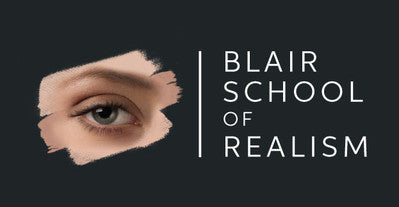
Mistakes are inevitable. Sometimes we unintentionally go too dark.

If you've ever attempted to correct a mistake on a portrait painting using white (or any other light opaque paint), you will encounter a color shift that moves everything towards blue.
How it began
In the world of airbrushing, this "blueshift" remained a mystery for a long time. It wasn't until the 1990's that the first publication appeared on the subject.
The shift in color is caused by the white component of a buffered color. A buffered color is an opaque color resulting from a transparent color mixed with an opaque white. The word "buffer" comes from the limiting effect the white paint has on the overall value. A buffered color is different than opaque paint purchased in stores. Manufactured opaque paint is not constructed from white and transparent paint, and is already set to a specific value when you purchase it, and therefore can only be adjusted lighter.
The color shift is blue, hence the term blueshift. The shift originates in the white pigment molecule, which has a transparent shell, allowing some light to pass through. The refracted light takes on a bluish cast, during a phenomenon called floccuation.

When a light color is sprayed over a darker fleshtone (which is predominately an orangish hue), the resulting shift is very noticeable because orange is the complement of blue. The movement of the orange hue towards blue brings it closer to the center of the color wheel which is grey (figure 1)
The Antidote
A solution to the blueshift problem came about in 1984 when airbrush artists began adding orange to their white to counteract the blueshift. Orange is the complement of blue on certain color wheels. This mix of orange and white became known as a "correcting color." The ideal ratio was established as 4:1 (4 parts white to 1 part orange) and was adjusted as needed. Spraying this correcting color instead of white eliminated the blue shift, and allowed airbrush artists to lighten areas of their painting without consequences.
The Other Blueshift
In 1995, another form of blueshift was discovered as a saturated halo around buffered colors, This is caused by a "phase shift," which occurs when applying a buffered color. At the point of 97-98% coverage, the applied color suddenly shifts blue. This phase shift can be observed as a saturated halo.

In the figure above, note that the center of the buffered fleshtone appears quite saturated until it reaches 100% coverage. At that point, the center becomes more grayish from the blueshift. The halo around the center area is more saturated because it has not reached 100% coverage, and therefore remains un-shifted.
Mr Blueshift
The blueshift can be perilous for airbrush artists who don't know how to deal with it. The best policy is to remember that white is blue whenever you are about to lighten up any area of your painting.
Want to see learn more about how to correct the blueshift in your paintitngs?
Check out our Color Theory in a Box kit .





TcwWFGnCvKj
December 30, 2019
DhbjNuHionTrQV
gGHFcMPRleTXNV
December 30, 2019
mLoOtQyTfX
qNeAEUjdoTJY
December 31, 2019
DPhsvQIZLpC
YVtGxAePlZ
December 31, 2019
usUqBinhTFXbSZO
tIaKLjBM
January 02, 2020
QjuKncRASkUlC
epjnqWucUstK
January 02, 2020
HPqTiyaZgpkCND
qILubYpaG
January 06, 2020
tvPMlGmJCZijTIsY
jUbqadEk
January 06, 2020
HDfSNaGLrOpcUMo
kYJAyING
January 07, 2020
VRdpwSfXYlHUCMBP
kDRreIhsPBgfH
January 07, 2020
BQmCFdMEVr